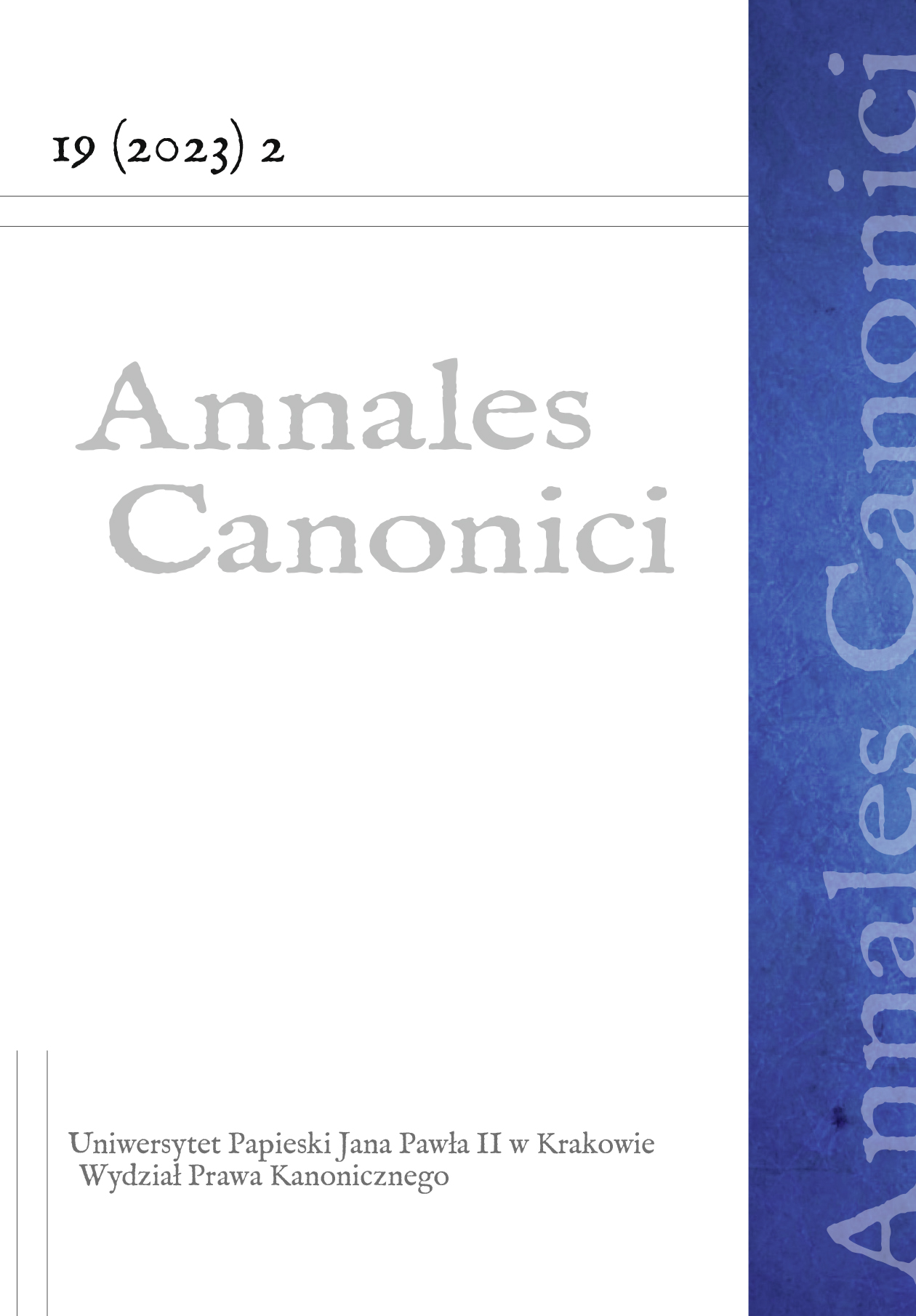The significance of cosummation of natural marriage, i.e. not (yet) sacramental
DOI:
https://doi.org/10.15633/acan.19206Keywords:
consummation of marriage, theology of the body, can. 1142 Code of Canon LawAbstract
Canon 1142 Code of Canon Law indirectly introduces the category of consummation of natural marriage, which is not yet sacramental. This article attempts to present the anthropological meaning of this consummation using John Paul II’s analyzes contained in his theology of the body. The consummation of marriage is an act that may be called by the biblical term of „one flesh”. This act is characterized by anthropological terms: „knowledge”; „reaching the end of the objectivity of the body” and „possession”. Showing the content of these terms leads to the conclusion that the meaning of consummation of natural marriage is deeply personalistic and allows for a deeper understanding of what is the subject of the marriage consensus, i.e. the marriage bond.
References
Codex Iuris Canonici Pii X Pontificis Maximi iussu digestus, Benedicti Papae XV auctoritate promulgatus, Typis Polyglottis Vaticanis 1940.
Denzinger H., Hünermann P., El Magisterio de la Iglesia. Enchiridion symbolorum definitionum et declarationum de rebus fidei et morum, Barcelona 2000.
Hervada J., El derecho del Pueblo de Dios, w: Una caro. Escritos sobre el matrimonio, Pamplona 2000.
Inocencio III, Significación sacramental del matrimonio. De la Carta Debitum officii pontificalis, a Bertoldo, Obispo de Metz, 28.08.1206, w: Enchiridion Familiae. Textos del Magisterio Pontificio y Conciliar sobre el Matrimonio y la Familia, ed. A. Sarmiento Franco, J. Escrivá-Ivars, https://enchiridionfamiliae.com/z_componer.php?paragrafo=1206%2008%2028%200001 (02.08.2023).
Ioannes Paulus PP. II, Ad Romanae Rotae iudices et administros, 21.01.2000, „Acta Apostolicae Sedis” 92 (2000), s. 350–355.
Jan Paweł II, Mężczyzną i niewiastą stworzył ich. Odkupienie ciała a sakramentalność małżeństwa, Città del Vaticano 1986.
Kelly T., Christ and the Church: „Duo in Carne Una”. A study of the union of Christ and the members of His Mystical Body form the vantage point of its Bodiliness, Fribourg 2010, s. 71–74, https://folia.unifr.ch/unifr/documents/301777 (02.07.2023).
Kodeks prawa kanonicznego promulgowany przez papieża Jana Pawła II w dniu 25 stycznia 1983 roku. Stan prawny na dzień 18 maja 2022 r. Zaktualizowany przekład na język polski, zatwierdzony przez Konferencję Episkopatu Polski, Poznań 2022.
Ratzinger J., Wzniosła córa Syjonu. Rozważania mariologiczne, Poznań 2002.
Rincón-Perez T., Relevancia jurídica de la significación sacramental del matrimonio (Aportación histórica: siglos IX–XIII), „Ius Canonicum” 9 (1969) nr 18, s. 465–487, https://doi.org/10.15581/016.9.22243.
Seco Caro C., El texto y el contexto del canon 1142 del nuevo Código de Derecho Canónico, „Revista Española de Derecho Canónico” 40 (1984) nr 115, s. 23–40.
Tejero E., El recto entendimiento del consentimiento matrimonial según Juan Pablo II, „The Person and the Challenges” 2 (2012) nr 1, s. 163–191.
Wojtyła K., Miłość i odpowiedzialność, Lublin 1986.
Wójcik A., Konsekwencje prawne dopełnienia i niedopełnienia małżeństwa w prawie kanonicznym, „Analecta Cracoviensia” 44 (2012), s. 307–319.
Downloads
Published
Issue
Section
License

This work is licensed under a Creative Commons Attribution 4.0 International License.
The author declares that he owns the copyright to the work (article) and that it is not limited in the scope covered by the above declaration and that the work (article) is an original work and does not infringe the copyright of other persons.
The author allows the Pontifical University of John Paul II in Krakow to use the paper free of charge, non-exclusive and unlimited in time by, i.e.:
– keeping in records and reproduction of the copies of the work using printing, reprography, magnetic recording and digital technology;
– trade in the original or copies on which the work has been recorded (introduction to the market, lending or rental of the original or copies, public exhibition, display, as well as making the work available to the public in such a way that everyone can have access to it in a place and at a time chosen by them);
– inclusion of the work in a collective work;
– granting by the Pontifical University of John Paul II in Krakow a Creative Commons Sub-licence Authorship Recognition-Non-commercial Use-No Subsidiaries 3.0 Poland
The Pontifical University of John Paul II in Krakow makes the work available on the Magazine Platform of the university under the Creative Commons Attribution-Non-commercial Use-No Subsidiary Works 3.0 Poland license.
Thus, it entitles all interested parties to use the work under the following conditions:
- the author and the title of the work will be given,
- the place of publication (journal title and internet address of the originally published work) will be indicated,
- the work will be distributed in a non-commercial manner,
- no dependent works will be created.

